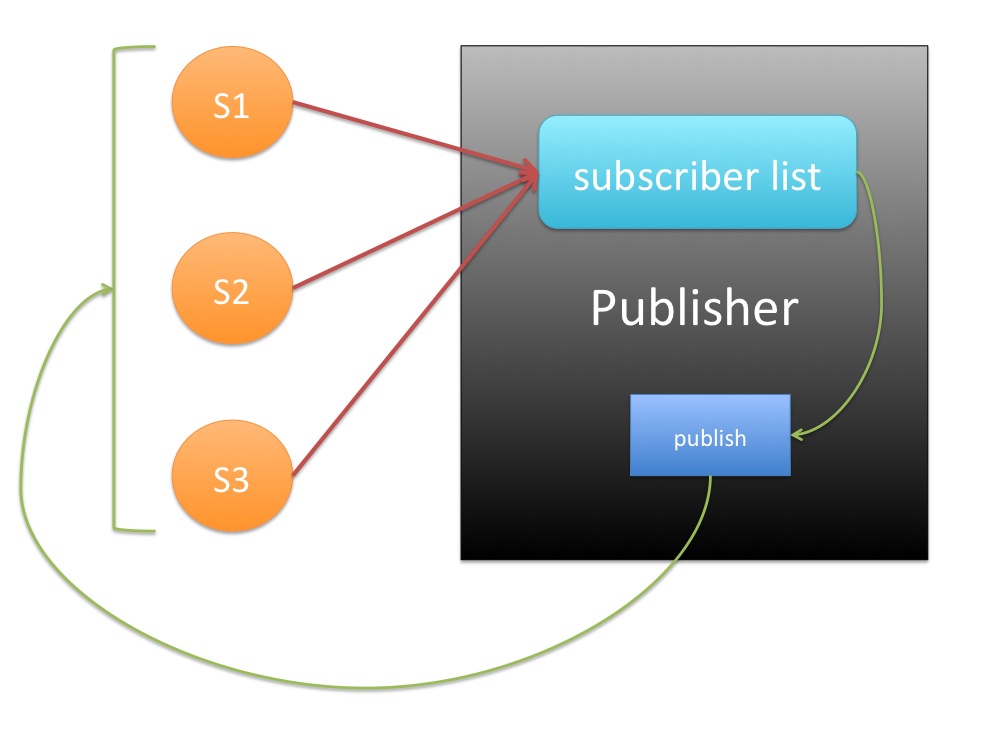架构设计之源:设计模式的场景分析(1)Publish-Subscribe
- Author: Poechant
- Blog: blog.CSDN.net/Poechant
- Email: zhongchao.ustc@gmail.com
- Date: February 24th, 2012
我在设计模式方面仅阅读过英文原版(或影印版)的书籍,以及一些互联网上的资料。而设计模式中有很多专有名词,概因我不知道部分中文译名是什么,所以本文以英文来写作。
1. Motivating Scenario
Have you ever encounter such a scenario: The data generatted by someone should be passed to the rest of others or some others in the program, and every receiver has a similar operation?
I think if you have some experience in software programming, there must be such scenarios. In the DP (Design Pattern) introduced in this article, the data generator or sender is called publisher and the receiver is called subscriber, just as you subscribe a RSS or a local newspaper and the postman sends those newspaper.
2. Publisher and Subscriber
Here is a Publisher interface. The subscribe method is used to register a subscriber to the publisher. Thepublish method is aimed at sending data to subscribers who have registered before.
// Poechant@CSDN
package com.sinosuperman.main;
public interface Publisher<E> {
public void subscribe(Subscriber<E> subscriber);
public void publish(E data);
}
Subscriber interface is as following. The method getPublication is invoked by the publisher to run the specific code implements by the subscribers.
// Poechant@CSDN
package com.sinosuperman.main;
public interface Subscriber<E> {
public void getPublication(E data);
}
The natural flow of publish-subscribe pattern

3. Example
Now we are trying to create a simple command processor, which has some basic functions as echo, quit and map.
3.1. Class implements Publisher
// Poechant@CSDN
package com.sinosuperman.main;
import java.io.BufferedReader;
import java.io.IOException;
import java.io.InputStreamReader;
import java.util.ArrayList;
import java.util.List;
public class InputLoop implements Publisher<String> {
private List<Subscriber<String>> subscribers;
private InputLoop() {
subscribers = new ArrayList<Subscriber<String>>();
}
public static InputLoop create() {
return new InputLoop();
}
@Override
//register subscriber
public void subscribe(Subscriber<String> subscriber) {
if (!subscribers.contains(subscriber)) {
subscribers.add(subscriber);
}
}
@Override
// Notify all subscribers
public void publish(String data) {
for (Subscriber<String> sub : subscribers) {
sub.getPublication(data);
}
}
public static String getInput() {
BufferedReader br = new BufferedReader(new InputStreamReader(System.in));
String response = "";
try {
response = br.readLine();
if (response == null) {
return "";
}
} catch (IOException e) {
}
return response;
}
public void loop() {
while (true) {
System.out.println("> ");
String s = getInput();
publish(s);
}
}
}
3.2. Classes implements Subscriber
Echo class could echo every string you input.
// Poechant@CSDN
package com.sinosuperman.main;
public class Echo implements Subscriber<String> {
private Echo() {
}
public static Echo create() {
return new Echo();
}
@Override
public void getPublication(String data) {
System.out.println("Got: " + data);
}
}
Map class could return the value according to the key you input.
// Poechant@CSDN
package com.sinosuperman.main;
public class Response implements Subscriber<String> {
private String ifthis;
private String thenthat;
private Response(String it, String tt) {
ifthis = it;
thenthat = tt;
}
public static Response create(String it, String tt) {
return new Response(it, tt);
}
@Override
public void getPublication(String data) {
if (data.equals(ifthis)) {
System.out.println(thenthat);
}
}
}
Quit class could execute the exit operation, then the program is halted.
// Poecahnt@CSDN
package com.sinosuperman.main;
public class Quit implements Subscriber<String> {
private Quit() {}
public static Quit create() {
return new Quit();
}
@Override
public void getPublication(String data) {
if (data.equals("quit")) {
System.exit(0);
}
}
}
3.3. Benchmark
Create an object of InputLoop and four subscribers.
package com.sinosuperman.main;
public class Test {
public static void main(String[] args) {
InputLoop il = InputLoop.create();
il.subscribe(Echo.create());
il.subscribe(Quit.create());
il.subscribe(Response.create("foo", "bar"));
il.subscribe(Response.create("1+1", "2"));
il.loop();
}
}
Test:
>
this is a string
Got: this is a string
>
help
Got: help
>
foo
Got: foo
bar
>
1+1
Got: 1+1
2
>
foo
Got: foo
bar
>
quit
Got: quit
-
转载请注明来自 Poechant@CSDN
-























 817
817

 被折叠的 条评论
为什么被折叠?
被折叠的 条评论
为什么被折叠?










